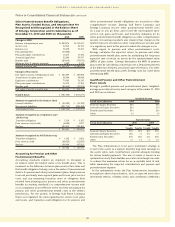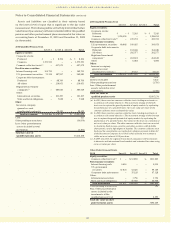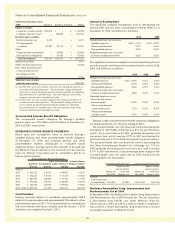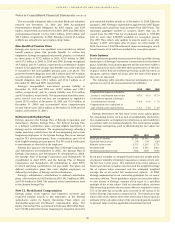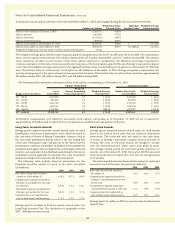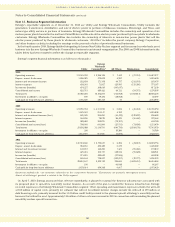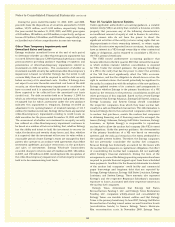Entergy 2010 Annual Report Download - page 107
Download and view the complete annual report
Please find page 107 of the 2010 Entergy annual report below. You can navigate through the pages in the report by either clicking on the pages listed below, or by using the keyword search tool below to find specific information within the annual report.
ENTERGY CORPORATION AND SUBSIDIARIES 2010
Notes to Consolidated Financial Statements continued
Electricity over-the-counter swaps that financially settle against
day-ahead power pool prices are used to manage price exposure
for Entergy Wholesale Commodities generation. Based on market
prices as of December 31, 2010, cash flow hedges relating to power
sales totaled $190 million of net gains, of which approximately
$155 million are expected to be reclassified from accumulated
other comprehensive income (OCI) to operating revenues in
the next twelve months. The actual amount reclassified from
accumulated OCI, however, could vary due to future changes
in market prices. Gains totaling approximately $220 million and
$322 million were realized on the maturity of cash flow hedges,
before taxes of $77 million and $113 million, for December 31,
2010 and 2009, respectively. Unrealized gains or losses recorded
in OCI result from hedging power output at the Entergy Wholesale
Commodities power plants. The related gains or losses from
hedging power are included in operating revenues when realized.
The maximum length of time over which Entergy is currently
hedging the variability in future cash flows with derivatives
(Palisades is price hedged through April 2022) for forecasted
power transactions at December 31, 2010 is approximately four
years. Planned generation currently sold forward from Entergy
Wholesale Commodities power plants as of December 31, 2010 is
96% for 2011 of which approximately 47% is sold under financial
derivatives and the remainder under normal purchase/sale
contracts. The ineffective portion of the change in the value of
Entergy’s cash flow hedges for 2010 and 2009 was insignificant.
Certain of the agreements to sell the power produced by Entergy
Wholesale Commodities power plants contain provisions that
require an Entergy subsidiary to provide collateral to secure
its obligations when the current market prices exceed the
contracted power prices. The primary form of collateral to satisfy
these requirements is an Entergy Corporation guaranty. As of
December 31, 2010, hedge contracts with two counterparties were
in a liability position (approximately $17 million total), but were
significantly below the amount of the guarantee provided under
the contract and no cash collateral was required. If the Entergy
Corporation credit rating falls below investment grade, the
impact of the corporate guarantee is ignored and Entergy would
have to post collateral equal to the estimated outstanding liability
under the contract at the applicable date. From time to time,
Entergy may effectively liquidate a cash flow hedge instrument
by entering into a contract offsetting the original hedge, and then
de-designating the original hedge. Gains or losses accumulated in
OCI prior to de-designation continue to be deferred in OCI until
they are included in income as the original hedged transaction
occurs. From the point of de-designation, the gains or losses on
the original hedge and the offsetting contract are recorded as
assets or liabilities on the balance sheet and offset as they flow
through to earnings.
Natural gas over-the-counter swaps that financially settle
against NYMEX futures are used to manage fuel price volatility for
the Utility’s Louisiana and Mississippi customers. All benefits or
costs of the program are recorded in fuel costs. The total volume
of natural gas swaps outstanding as of December 31, 2010 is
37,120,000 MMBtu for Entergy. Credit support for these natural
gas swaps is covered by master agreements that do not require
collateralization based on mark-to-market value, but do carry
adequate assurance language that may lead to collateralization
requests.
The effect of Entergy’s derivative instruments not designated
as hedging instruments on the consolidated income statements
for the years ended December 31, 2010 and 2009 is as follows
(in millions):
Amount of gain (loss)
recognized in OCI Amount of gain (loss)
(de-designated Income Statement recorded in
Instrument hedges) location income
2010
Natural gas swaps $ – Fuel, fuel-related $ (95)
expenses, and gas
purchased for resale
Electricity futures, fowards, Competitive
swaps, and options de- businesses operating
designated as hedged items $15 revenues $ –
2009
Natural gas swaps $ – Fuel, fuel-related $(160)
expenses, and gas
purchased for resale
Due to regulatory treatment, the natural gas swaps are marked to
market through fuel, fuel-related expenses, and gas purchased for
resale and then such amounts are simultaneously reversed and
recorded as offsetting regulatory assets or liabilities. The gains or
losses recorded as fuel expenses when the swaps are settled are
recovered through fuel cost recovery mechanisms.
Fair Values
The estimated fair values of Entergy’s financial instruments and
derivatives are determined using bid prices, market quotes,
and financial modeling. Considerable judgment is required in
developing the estimates of fair value. Therefore, estimates are
not necessarily indicative of the amounts that Entergy could
realize in a current market exchange. Gains or losses realized
on financial instruments other than forward energy contracts
held by competitive businesses are reflected in future rates
and therefore do not accrue to the benefit or detriment of
shareholders. Entergy considers the carrying amounts of most
financial instruments classified as current assets and liabilities to
be a reasonable estimate of their fair value because of the short
maturity of these instruments.
Accounting standards define fair value as an exit price, or the
price that would be received to sell an asset or the amount that
would be paid to transfer a liability in an orderly transaction
between knowledgeable market participants at the date of
measurement. Entergy and the Registrant Subsidiaries use
assumptions or market input data that market participants would
use in pricing assets or liabilities at fair value. The inputs can
be readily observable, corroborated by market data, or generally
unobservable. Entergy and the Registrant Subsidiaries endeavor
to use the best available information to determine fair value.
105


